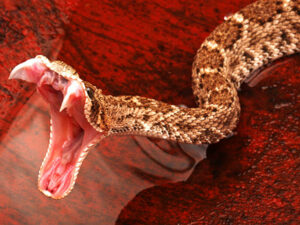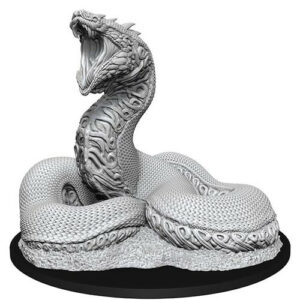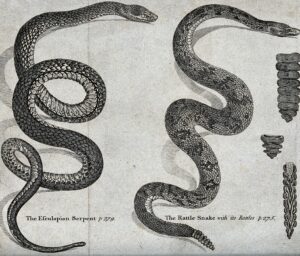Although the terms “snake” and “serpent” are often used interchangeably, in current parlance, “serpent” is more commonly used as a metaphor, particularly when referring to someone who is exceedingly dishonest.
A monster that resembles a dragon, lizard, or snake is referred to as a serpent in several mythologies. As was said before, the term “serpent” may also be used to refer to dragons and firedrakes in mythology and works of art.
Another term that is connected to that is serpentine, which is used to describe anything that is wavy or wiggly. Similar to “The road wound around in a very winding manner.” Although it’s not a very popular term, knowing it may come in rather helpful.
Many animals prey on snakes, some of which include huge raptors, feral pigs, cobras, foxes, bears, dogs, and even other snakes. Even other snakes feed on snakes. Even the biggest and most terrifying snakes have reasons to be afraid of certain things, which may come as a surprise to some people.
Key differences simplified
Serpent: When used as nouns, serpent and snake refer to the same thing: a snake. However, when used as verb, serpent refers to a legless reptile of the suborder Serpentes that has a long, thin body and a tongue in the form of a fork.
Snake: When employed as verbs, serpent and snake both mean to wind or meander, but snake also means to go along a winding course, whereas serpent means to wind or meander.
Meaning:
| Serpent | Snake |
| Many cultures throughout the globe pass down legends about sea serpents, which may be some of the earliest accounts of human history. According to the bestiary, snakes and serpents are intimately connected. | Snakes are real animals that might be tracked down in the southern Pacific Sea and the Indian Sea. The longest can arrive at just about nine feet long, which is sufficiently astonishing to bring forth stories. In specific societies, snakes are an image of ripeness or an imaginative life force. |
| It is common practice to compare dragons to the biggest of serpents. In this sense, dragons are symbolic representations of the Devil, who is also often portrayed as a gigantic serpent. | Snakes are viewed as images of resurrection, change, everlasting status, and mending because of their capacity to lose their skin using an interaction known as sloughing. The Ouroboros is an image that addresses time everlasting as well as the ceaseless pattern of life. |
Example:
- There are over 3,400 different species of reptiles that are classified under the subfamily Serpentes.
- One of them is the snake, which is also called a serpent due to the lack of limbs it has as well as the width of its head and tail.
Other Similar Terms
Why are they called serpent snakes?
 In popular parlance, particularly big or venomous snakes are referred to as serpents, and according to biblical tradition, the form that Satan adopted to tempt Eve was that of a serpent.
In popular parlance, particularly big or venomous snakes are referred to as serpents, and according to biblical tradition, the form that Satan adopted to tempt Eve was that of a serpent.
But if we’re going to be pedantic, we should note that the word “serpent” originates from the Latin word “serpent,” which means “to crawl.
Who is the god of the serpent?

Quetzalcoatl. A closer look at a piece of Aztec artwork that depicts the deity Tez-Calipoca and Quetzalcoatl (on the right) consuming a human person.
Quetzalcoatl, otherwise called the “Padded Snake,” was perhaps the main god in the development of Mesoamerica. He was a half and half of a bird and a diamondback.
What is a snake called in the bible?

Both the Old Testament and the New Testament make mention of serpents (Hebrew: n, romanized: n).
The Hebrew word for serpent is n. In ancient Greece, Persia, Babylonia, and Palestine, the representation of a serpent or snake played significant roles in the cultural and religious practices of those civilizations.
Who killed the world serpent?
Thor yanks the snake out of the sea, and the two of them confront each other as Jormungandr blows poison in their faces. Fear causes Hymir’s face to become pale. The giant breaks the connection just as Thor is about to slay the snake with his ax.
This allows the serpent to return to its previous position of circling the earth under the seas and be free from Thor’s attempt to kill it.
What does the serpent symbolize?

Throughout history, serpents and snakes have been seen as symbols of fertility or the creative energy of life.
Snakes are viewed as images of resurrection, change, interminability, and mending because of their capacity to lose their skin through a cycle known as sloughing.
The Ouroboros is an image that addresses endlessness as well as the ceaseless pattern of life.
LIVE DICTIONARY – 4K Animal Footage ~ SNAKE | CON RẮN | SERPENT | SCHLANGE | ヘビ | 뱀 | 蛇 | n39 vlog
- Thus Far vs So Far [Which is Correct?] - September 3, 2023
- Uled vs Oled in 2024 [Which is Better?] - September 3, 2023
- Scarlet vs Red [Difference Explained] - September 3, 2023

![Difference Between Faerie vs Fairy? [Explained] Faerie vs Fairy](https://bitdifference.com/wp-content/uploads/2022/11/farries-vs-farrie-150x150.jpg)
![What is Post & Pre? [Examples] Post vs Pre](https://bitdifference.com/wp-content/uploads/2022/11/pre-vs-post-150x150.jpg)
![Men vs Man in 2024 [Explained] Men vs Man](https://bitdifference.com/wp-content/uploads/2022/11/427-Man-vs-Men.jpg)
![Perform vs Preform [Meaning] perform-vs-preform](https://bitdifference.com/wp-content/uploads/2022/11/perform-vs-preform.jpg)
![Difference Between Ton vs Tonne [Explained] Ton vs Tonne](https://bitdifference.com/wp-content/uploads/2022/11/ton-vs-tonne-difference.jpg)
![Faithful vs Loyal [Which is Better?] Faithful vs Loyal](https://bitdifference.com/wp-content/uploads/2022/11/question-1.jpg)

